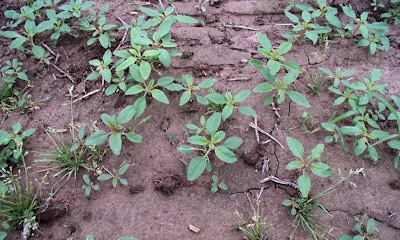
Bill Johnson saw more waterhemp in 2015 than in his previous 13 seasons walking Indiana fields. He says it’s a weed that deserves your attention as you put together 2016 weed control plans.
Johnson, Purdue University Extension weed control specialist, says the wet early growing season probably gave waterhemp a boost. Many people couldn’t spray on time, and the weed got a foothold. In contrast Palmer amaranth didn’t fare as well, and wasn’t as troublesome in last year. But it could make a return in a more normal season, Johnson emphasizes.
Here is a five-step process that could help you avoid head-scratching problems with waterhemp this year.

GET OUT THERE SOONER: These waterhemp plants are already taller than specified as the upper limit for control on many herbicide labels.
Step one. Acknowledge there is a big seed bank
With as rampant as waterhemp became in some Indiana fields last season, Johnson is confident there is likely a large seed bank built up in many areas. This weed has traditionally been more of a problem farther west, in Illinois, Missouri and Iowa. Johnson says it’s time to recognize it could be a problem on your farm. The seed bank is bulging!
Step two. Understand many waterhemp plants are resistant to various herbicides
“All of them are resistant to ALS chemistry, and a good chunk are resistant to glyphosate,” Johnson says. “There is growing concern that some are resistant to PPO herbicides too. Some plants may be resistant to all three modes of action.” (And if you wondered, ALS stands for acetolactate synthase; PPO stands for protoporphrinogen oxidase, we stick with the abbreviations)
Step three. More weapons to control waterhemp in corn
Atrazine, dicamba, 2-4,D, Callisto, Impact and Laudis are effective against waterhemp in corn. Soil-applied herbicides such as Dual, Surpass/Harness, Outlook and Zidua may also be effective. Going with soil-applied herbicides and not letting weeds get a head start is key now, Johnson says. Weed resistance is one reason why residuals are so important to the system.
Related: Waterhemp is getting pretty big what can I do?
Step four. Soil-applied options in soybeans
Waterhemp is most troublesome in soybeans because there are fewer control options, Johnson says. “I would treat them as if they’re both ALS and glyphosate resistant from the start,” he says. “Getting residual herbicides down is crucial. Either Valor or Authority-based pre-emerge herbicides are a good place to start.”
Come back post with FlexStar or Cobra in Roundup Ready soybeans or FlexStar or Cobra and Liberty in Liberty Link soybeans, he suggests
Step five. Carry a ruler or tape measure, and spray weeds on time!
“The key is to spray post when weeds are three to four inches tall,” he says. One reason waterhemp got away in ’15 was because plants were much taller when applications could be made due to wet soils that prohibited spraying.
Both FlexStar and Cobra are PPO herbicides. If waterhemp in Roundup Ready soybeans are also PPO resistant, you’re out of options besides hand-pulling, Johnson says. It’s another reason why making a residual application is crucial.
About the Author(s)
You May Also Like




